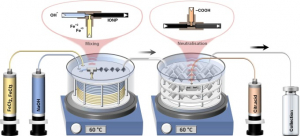
Maximilian O. Besenhard, Alec P. LaGrow, Aden Hodzic, Manfred Kriechbaum, Luca Panariello, Giorgio Bais, Katerina Loizou, Spyridon Damilos, M. Margarida Cruz, Nguyen Thi Kim Thanh, Asterios Gavriilidis
Co-precipitation is by far the most common synthesis for magnetic iron oxide nanoparticles (IONPs), as cheap and environmentally friendly precursors and simple experimental procedures facilitate IONP production in many labs. Optimising co-precipitation syntheses remains challenging however, as particle formation mechanisms are not well understood. This is partly due to the rapid particle formation (within seconds) providing insufficient time to characterise initial precipitates. To overcome this limitation, a flow chemistry approach has been developed using steady-state operation to “freeze” transient reaction states locally. This allowed for the first time a comprehensive analysis of the early stages of co-precipitation syntheses via in-situ Small Angle X-ray Scattering and in-situ synchrotron X-Ray Diffraction. These studies revealed that after mixing the ferrous/ferric chloride precursor with the NaOH base solution, the most magnetic iron oxide phase forms within 5 s, the particle size changes only marginally afterwards, and co-precipitation and agglomeration occur simultaneously. As these agglomerates were too large to achieve colloidal stability via subsequent stabiliser addition, co-precipitated IONPs had to be de-agglomerated. This was achieved by adding the appropriate quantity of a citric acid solution which yielded within minutes colloidally stable IONP solutions around a neutral pH value. The new insights into the particle formation and the novel stabilisation procedure (not requiring any ultra-sonication or washing step) allowed to design a multistage flow reactor to synthesise and stabilise IONPs continuously with a residence time of less than 5 min. This reactor was robust against fouling and produced stable IONP solutions (of ~1.5 mg particles per ml) reproducibly via fast mixing (< 50 ms) and accurate temperature control at large scale (> 500 ml/h) for low materials cost.
Doi: 10.1016/j.cej.2020.125740
Cited as: Besenhard MO, LaGrow AP, Hodzic A, Kriechbaum M, Panariello L, Bais G, Loizou K, Damilos S, Cruz MM, Thanh NTK, Gavriilidis A (2020) Co-precipitation synthesis of stable iron oxide nanoparticles with NaOH: New insights and continuous production via flow chemistry. Chemical Engineering Journal 399, 125740; https://doi.org/10.1016/j.cej.2020.125740.



